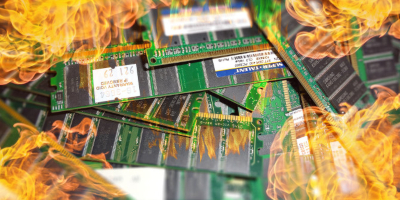The First Step To Being More Productive: Getting Things Off Your Mind
In the book Getting Things Done, David Allen shares this about the human mind…
The short-term memory part of your mind – the part that tends to hold all of the incomplete, undecided, and unorganized stuff – functions much like RAM on a computer. Your conscious mind, like the computer screen is a focusing tool, not a storage place. You can think about only two or three things at once. But the incomplete items are still being stored in the short-term-memory space. And as with RAM, there’s limited capacity; there’s only so much stuff you can store in there and still have that part of your brain function at a high level.
Most people walk around with their RAM bursting at the seams. Studies have demonstrated that our mental processes are hampered by the burden put on the mind to keep track of things we’re committed to finish, without a trusted plan or system in place to handle them. As soon as you tell yourself you might need to do something, and store it only in your head, there’s a part of you that thinks you should be doing that something all the time.
Focusing on the most important things to do
In the last post of this series, I talked about 3 quick questions that can get you being more productive right away. They were…
-
What is the task or situation that is most on your mind or most important to you at this moment?
-
What would you consider to be a successful outcome for the task or situation?
-
What is the next action you need to do to move the task or situation forward?
While these are tremendously helpful to refocus your mind in the moment, they have a limitation – they only focus on what’s most on your mind at that moment, which isn’t always the most important or urgent thing to do. What about the things you’ve forgotten about? Just because you’re not thinking about them right now doesn’t mean they’re not important. All of us have forgotten about things that were important and slipped our minds. We can’t just rely on our recall if we want to be as productive as we can be.
In order to be in complete control, we need techniques and tools that will help us to bypass our imperfect memories and allow us to consistently take stock of what possible to do’s we have and how they should be prioritized. We need to get things off our minds.
The best way to do this is to capture them somewhere that’s not IN your mind. We need places to capture everything that comes to mind that we consider to be incomplete and we want or need to change. This tool becomes a way for your mind to let go of each incomplete item that enters it, thereby freeing your mental space to focus on other things that are more important and leaving room for other ideas to enter.
This kind of tool does a couple of things. First, it eliminates the constant internal nagging you experience when you don’t get something off your mind. You know, when you say to yourself “I can’t forget to do this,” and then find yourself thinking about that thing constantly to keep yourself from forgetting. I still sometimes forget when I try this method :).
The other thing it does is guard against the unintentional escape of things from your mind. We’ve all also completely forgotten to do something important in the past. Heck, I even forget to go to a friend’s wedding because I didn’t capture it on my calendar. That was not my best moment!
It’s more than a To-Do List
Now, you might be thinking this just sounds like I’m making a to-do list. Yes, but not the type that are typically made. The problem with periodic to-do lists is that they only include items that you can recall at that given point in time. You sit down and you make a to-do list. Whatever makes the list at any given point in time is eligible to be done. Again, we don’t want to leave what we’re doing at any given point in time simply up to memory or what we feel like doing right then.
When we do this, we’re not in complete control of our productivity then, and it hampers us.
Instead, we want to have a capturing tool (OK, call it a to-do list if you want) that has these characteristics…
- They include everything. If you don’t, the things that grab your attention will automatically take over, rather than falling in line where you decide they deserve to be. If you don’t capture everything, you won’t be able to put them in their rightful place of priority. This throws you all out of whack. Once you do this, everything is now off your mind and it frees you up to focus on the most important things.
- It’s always available. This means you can access it when you’re doing almost anything and you’re in almost any place. The most important things to do will sometimes come to you at the least opportune times for capturing, like in the shower, driving your car, on a long hike, etc.
- They’re easy to reorganize and empty. These are not set in stone and you need to make progress. Life is a fluid thing, so your list has to be too.
- You can create and filter categories and projects. I find this helpful because it allows me to focus on the particular project I’ve decided is my top priority at any given point in time.
How I capture to get things off my mind
What is my capturing method that meet these criteria?
Personally, I use Google spreadsheets that I can access from my computer or phone at any time. I have 2 separate sheets – one for work and one for personal. Since there are natural time boundaries between work and personal time, I feel it helps me to keep them separate.
In my Google spreadsheet, there are 2 tabs – 1 for Projects and 1 for Next Actions. In each tab, there are columns for Priority, Client, Notes, Deadline, and Next Date. Because all of these columns can be filtered and sorted, it allows me to constantly assess what’s most important at any particular point in time and re-organize my list.
Here’s my Projects tab…
This is where I capture high-level stuff that needs to be done. These are not specific actions to take. They are more like project titles like “write a blog post series on productivity.” This gets reviewed about once a week to reprioritize projects. The specific actions to take for each project are reserved for my Next Actions tab. Here’s what that looks like…
For this tab, I added in Next Action and Completed columns.
Bring back the 3 questions
I can take the 3 questions from above, apply them to the spreadsheet and now I know exactly what I’m going to work on next. As soon as I’m done with that task, I simply go to the next one while constantly reassessing and reorganizing.
By doing this, I get to be in control of deciding what the very next action I need to take is for the project that is the highest priority right now given all of my current circumstances (people available, time until you have to do something else, etc.).
I’m always working on what I decide is the most important thing at any given point in time, not just what’s on my mind the most.
By capturing everything to do in your life, you’ll take total control of how your time is spent and be as productive as possible.





